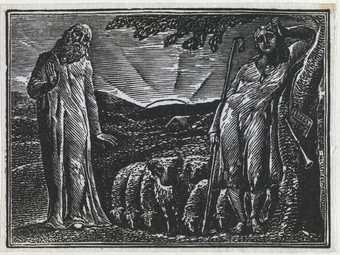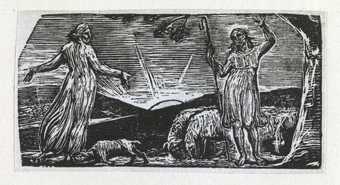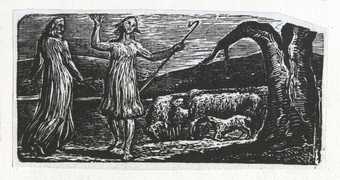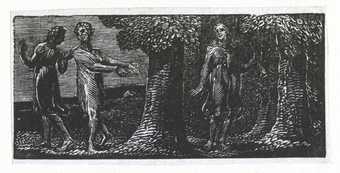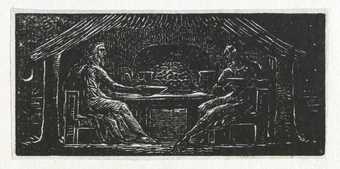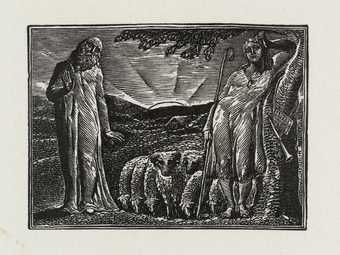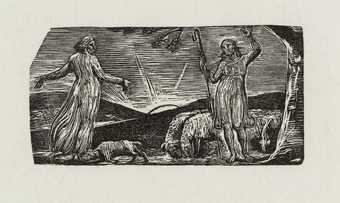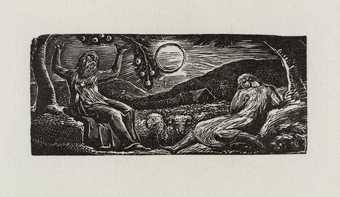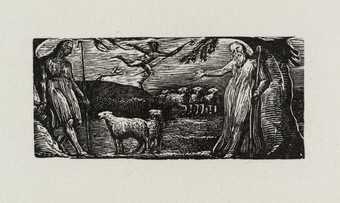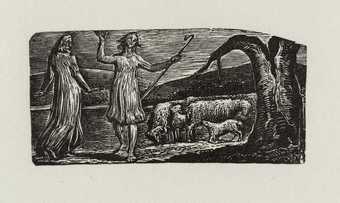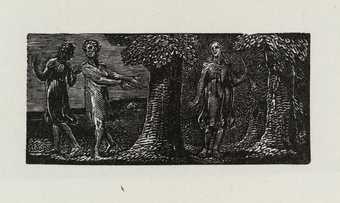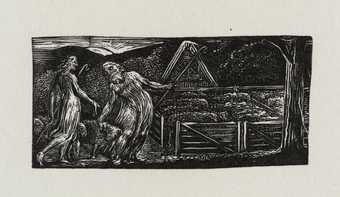
In Tate Britain
Prints and Drawings Room
View by appointment- Artist
- William Blake 1757–1827
- Medium
- Wood engraving on paper
- Dimensions
- Image: 33 × 75 mm
- Collection
- Tate
- Acquisition
- Presented by Herbert Linnell 1924
- Reference
- A00113
Display caption
Gallery label, August 2004
Does this text contain inaccurate information or language that you feel we should improve or change? We would like to hear from you.
Catalogue entry
A00113 [from] Illustrations to Thornton's Pastorals of Virgil
1821/c.1830 [A00111-A00127; complete]
A00111-A00127/-
Seventeen wood-engravings on commercial thin wove paper
Presented by Herbert Linnell 1924
PROVENANCE John Linnell: by descent to Herbert Linnell
LITERATURE [Henry Cole] ‘Fine Arts, The Vicar of Wakefield, With thirty-two Illustrations. By W. Mulready, R.A. van Voorst’, Athenaeum 21 January 1843, p.165; Gilchrist 1863, 1, pp.270–5; A.H. Palmer Life and Letters of Samuel Palmer 1892, p.15; Russell Engravings 1912, pp.97–101 no.30; Keynes Bibliography 1921, pp.211–14 no.778; Geoffrey Keynes Illustrations of William Blake for Thornton's Virgil 1937; Keynes Engravings 1950, pp.15–16, series repr. pls.1–XVII; Raine 1968, 11, pp.279–80; Bentley Blake Records 1969, pp.266–8, 271–3, 582; Keynes Blake Studies 1971, pp.136–42, 215–16; Easson and Essick, 1, 1972, pp.48–50 no.X, series repr.; Bentley Blake Books 1977, pp.627–30 no.504; Iain Bain, David Chambers and Andrew Wilton The Wood Engravings of William Blake for Thornton's Virgil 1977, published with restrikes (see nos.90–106); Bindman 1977, pp.204–5; Bindman Graphic Works 1978, p.485, nos.602–18, series repr.; Paley 1978, p.69; Essick Printmaker 1980, pp.224–33; Butlin 1981, pp.532–5
These are separate impressions from Blake's original wood-blocks, probably made by Edward Calvert (1799–1883), one of the Ancients who gathered round Blake in his later years and also a friend of John Linnell, for Linnell who actually owned the blocks. For a more recent set of impressions see T02115-T02131.
Blake's wood-engravings were commissioned by Dr Robert John Thornton through John Linnell, whose doctor he was. Blake first met Thornton in September 1818 and by September 1820 Blake was actually working on the engravings which were commissioned for the third edition of Dr Thornton's The Pastorals of Virgil ... adapted for Schools, published in 1821; the first unillustrated edition had been published in 1812. Beside these seventeen engravings after his own designs for Ambrose Philip's ‘Imitation of Virgil's First Eclogue’, Blake engraved on copper five busts of Theocritus, Virgil, Caesar Augustus, Julius Caesar and Epicurus, and a group of five medallion heads ‘From Antique Coins’. In addition, he is credited with the drawing of ‘The Giant Polypheme’ after Poussin that was engraved by Byfield; however, Linnell wrote in his Journal on 18 October 1820 that he himself ‘Began a small Drawing on a wood Block of Polypheme (from N. Poussin) for Dr Thornton’ and that he was ‘to receive a guinea for it’ (Bentley 1977, p.629). The Pastorals
contain 232 illustrations in all.
The existence, if not the present location, of twenty of Blake's original drawings for the illustrations to Philip's ‘Imitation’ is known (see Butlin 1981 no.769; nos.1–4, 6–11, 13–17 and 19–20 are repr. pls.999A, 999A, 1000–1014). Of Blake's designs no.4, ‘Colinet and Thenot stand together conversing, their sheep behind’ (Pierpont Morgan Library, New York) was not engraved. No drawing for the frontispiece, which is larger in format and shows Thenot and Colinet, has been recorded. Some of Blake's other engravings where lost as a result of Dr Thornton's dissatisfaction; indeed, only a chance conversation between Sir Thomas Lawrence, James Ward, Linnell and others at Mr Ader's prevented all of them from being recut by a commercial engraver. Three, corresponding to the drawings Butlin nos.769 14–16, did suffer this fate (repr. Bentley 1969, pl.41). The design no.769 2 was also recut (repr. Athenaeum 21 January 1843, p.165, and Keynes 1971, pl.35) but in this case Blake's original engraving was retained. In the end Thornton published Blake's engravings with the disclaimer that ‘they display less of art than genius, and are much admired by some eminent painters’.
Apart from the frontispiece, Blake cut his designs four on a block and proofs of eight of the designs from two blocks are in the British Museum and elsewhere. When they came to be printed in the book they were indeed printed four to a page but simple captions were placed under each design; this entailed cutting each design by about 3/16× 3/8 (4×9).
On 16 September 1825 John Linnell bought the blocks from Dr Thornton for two guineas and, according to a manuscript ‘List’ of Linnell's ‘Letters and Papers’ by John Linnell jr (in the Ivimy MSS), ‘E. Calvert printed them for J.L. & self, &c (certain number of imprints of the set) (J.L. jnr & brother printed a few of the blocks, but did not finish the set)’. Calvert's printings were apparently done soon after Blake's death, both for Calvert himself and Linnell. As the set of impressions presented to the Tate Gallery by Henry Linnell in 1924 is complete, it was presumably one of those printed by Calvert.
The blocks themselves were rediscovered in 1937, still in the possession of Linnell's descendants, by Sir Geoffrey Keynes, who had electrotypes made from them and printed from these electrotypes for his edition of The Illustrations of William Blake for Thornton's Virgil published that year. The blocks were sold from the Linnell estate at Christie's on 2 December 1938 and presented by the National Art-Collections Fund to the British Museum (accession nos.1939-14-1-2 to 18).
These tiny woodcut illustrations, though untypical of Blake's art as a whole, were the most influential of all his works on other artists by way of the work of the Ancients, particularly Calvert and Samuel Palmer. As Samuel Palmer wrote (A.H. Palmer 1892): ‘I sat down with Mr. Blake's Thornton's Virgil woodcuts before me, thinking to give their merits my feeble testimony. I happened first to think of their sentiment. They are visions of little dells, and nooks, and corners of Paradise; models of the exquisitest pitch of intense poetry. I thought of their light and shade, and looking upon them I found no word to describe it. Intense depth, solemnity, and vivid brilliancy only coldly and partially describe them. There is in all such a mystic and dreamy glimmer as penetrates and kindles the innermost soul, and gives complete and unreserved delight, unlike the gaudy daylight of this world. They are like all that wonderful artist's works the drawing aside of the fleshy curtain, and the glimpse which all the most holy, studious saints and sages have enjoyed, of that rest which remaineth to the people of God’. The influence of the designs extended well into the twentieth century, for instance in the early etchings of Graham Sutherland.
These works were formerly inventoried as nos.3866 i–xvii.
A00113 Plate 3: Thenot and Colinet Converse Seated between Two Trees
Wood-engraving 33×75 (1 5/16×2 9/16) on paper 35×77 (1 3/8×3)
Thenot describes his own body bowing down as ‘trees beneath their fruit in autumn bend’, and this is illustrated literally by Blake.
The drawing cannot be traced since it was exhibited in Philadelphia in 1939 (132) (Butlin no.769 2, pl.999A). This was one of the designs that Thornton had reengraved, in reverse, but in this case Blake's own engraving was in fact used in the book.
Published in:
Martin Butlin, William Blake 1757-1827, Tate Gallery Collections, V, London 1990
Explore
- literature and fiction(3,138)
-
- classical(198)
- literature (not Shakespeare)(2,276)
- food and drink(980)
-
- fruit - non-specific(173)
- actions: expressive(2,622)
-
- talking(602)
- arm / arms raised(839)
- sitting(3,347)
- man(10,453)
You might like
-
William Blake Frontispiece: Thenot and Colinet
c.1821, printed 1830 -
William Blake Thenot Remonstrates with Colinet
c.1821, printed 1830 -
William Blake Thenot Remonstrates with Colinet; Lightfoot in the Distance
c.1821, printed 1830 -
William Blake Thenot, with Colinet Waving his Arms in Sorrow
c.1821, printed 1830 -
William Blake Colinet with his Shepherd’s Pipe, Mocked by Two Boys
c.1821, printed 1830 -
William Blake Thenot and Colinet Folding their Flocks together at Sunset
c.1821, printed 1830 -
William Blake Thenot and Colinet at Supper
c.1821, printed 1830 -
William Blake Thenot and Colinet
1821, reprinted 1977 -
William Blake Thenot Remonstrates with Colinet
1821, reprinted 1977 -
William Blake Thenot and Colinet Converse Seated between Two Trees
1821, reprinted 1977 -
William Blake Thenot Remonstrates with Colinet: Lightfoot in the Distance
1821, reprinted 1977 -
William Blake Thenot, with Colinet Waving his Arms in Sorrow
1821, reprinted 1977 -
William Blake Colinet with his Shepherd’s Pipe, Mocked by Two Boys
1821, reprinted 1977 -
William Blake Thenot and Colinet Folding their Flocks together at Sunset
1821, reprinted 1977 -
William Blake Thenot and Colinet at Supper
1821, reprinted 1977

